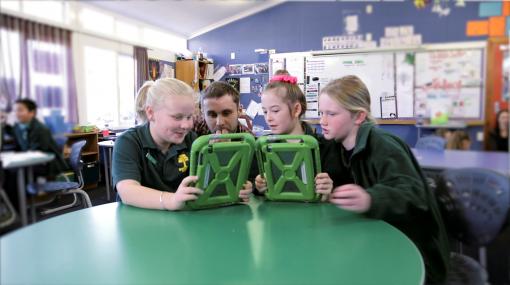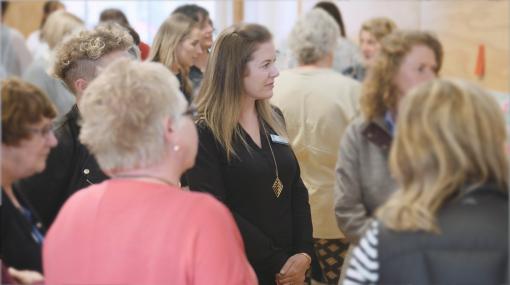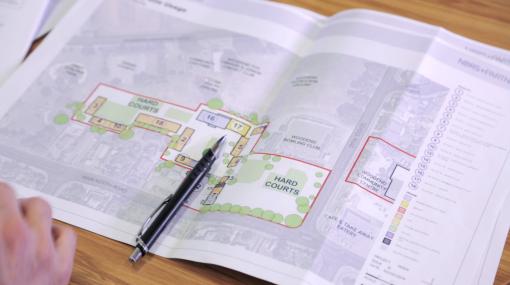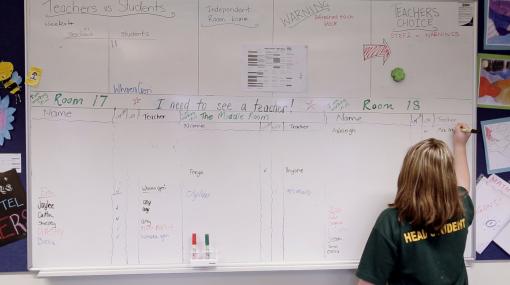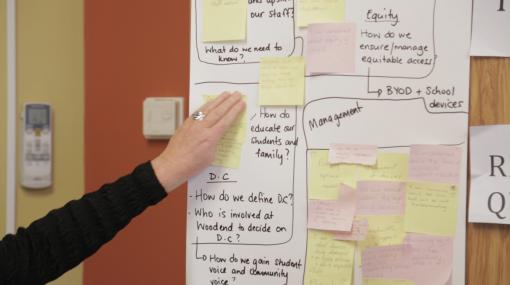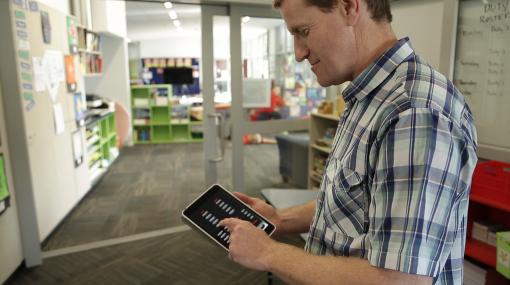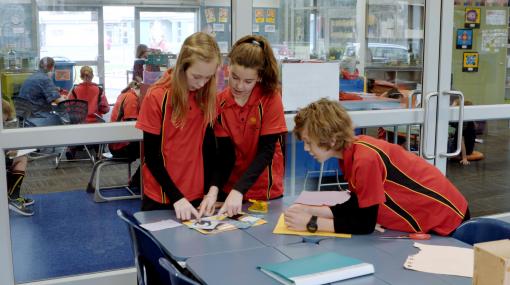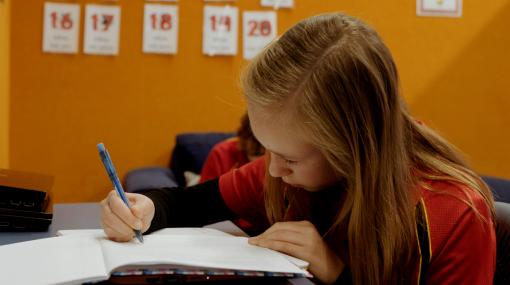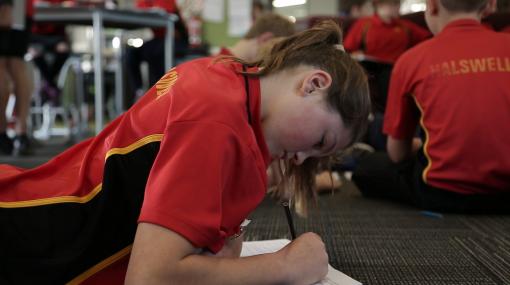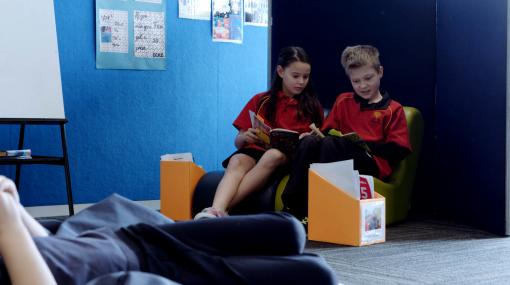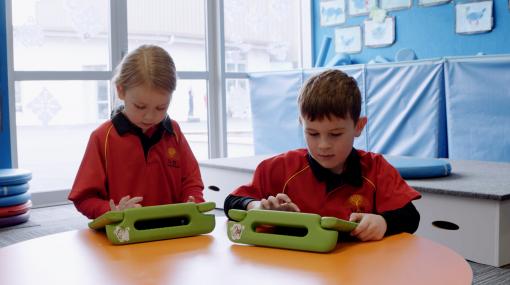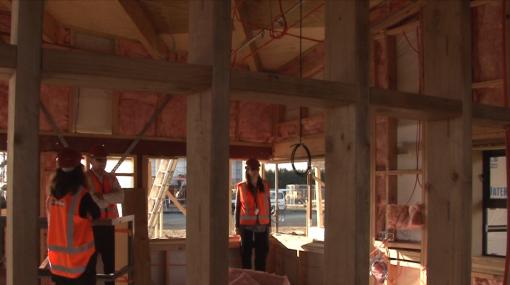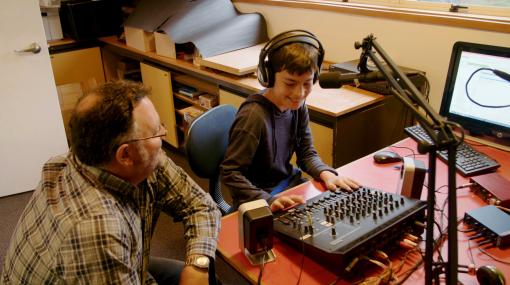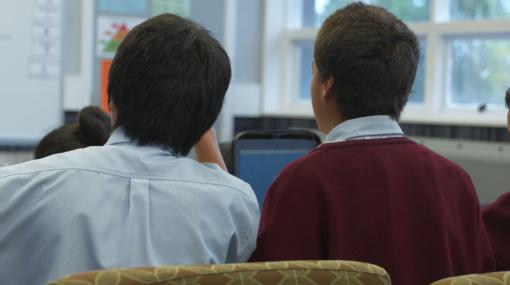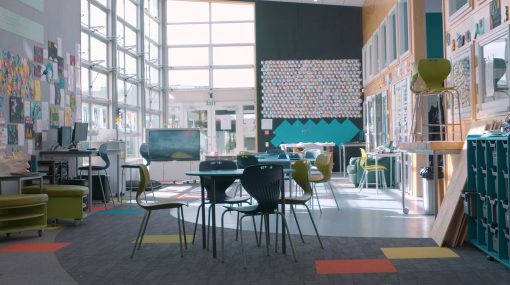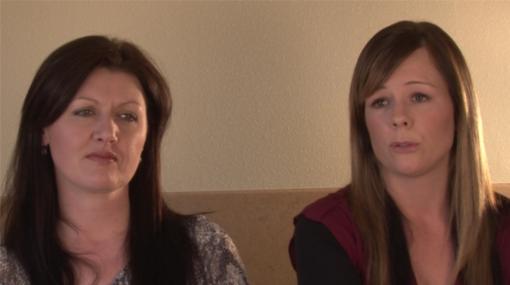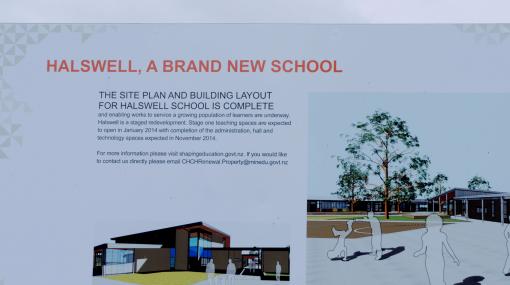Planning and developing an innovative learning environment
Effective pedagogy underpins practice in an innovative learning environment.
What is an innovative learning environment?
An innovative environment (ILE) is one that is capable of evolving and adapting as educational practices evolve and change – thus remaining future-focused.
In the past, the term "Modern Learning Environments" (MLE) was used. "Innovative Learning Environments" (ILE) has greater international recognition, and is used by The Ministry of Education.
A learning environment includes the physical, social, and pedagogical context in which learning occurs. An ILE supports strengths-based teaching and learning. It offers students and teachers flexibility, agency, ubiquity, and connectedness.
Working in an ILE where teaching and learning is collaborative, reflections and inquiries are shared, and communities are engaged leads to a more robust, continuously improving community of practice.
What is a flexible learning space?
Physical spaces are only a part of the contribution to an innovative learning environment.
A flexible learning space (FLS) has the right acoustics, lighting, technology, heating and air quality to support learning. The spaces can be easily configured and used in a number of different ways to support and enable a range of teaching and learning approaches on any given day or at any time of the day. They can support single teacher whole ‘class’ teaching practice and can adapt to a broader range of teaching and learning practices and groupings as a school’s education practices evolve over time.
Innovative teaching practices flourish when:
- Teacher collaboration focuses on supporting peers and sharing teaching practices.
- Professional development involves the active and direct engagement of teachers, particularly in practising and researching new teaching methods.
- The school culture offers a common vision of innovation, as well as consistent support that encourages new types of teaching.
Future-focused learning in connected communities, May 2014 - The most important first step when developing an ILE is to focus on learning.
Getting started
Articulating the why of change
In this video, Dr Julia Atkin explains the importance of articulating what it is you are trying to improve before beginning your planning. Ask - What can we do differently that will improve learning outcomes? How will we develop key competencies in an innovative learning environment?
Key things to consider
- Your school’s vision for learning. How are the school community involved in this vision?
- Seven principles of learning (pp 6–7) – How are these principles guiding your planning?
- The design – what is needed to create an inclusive, future-proofed, multipurpose design that realises your school vision?
- Professional learning – what is needed to support teachers and students to prepare for successful learning and teaching within an ILE?
- Infrastructure and technologies – what is needed to support the learning and teaching in the space.
- Resourcing and planning – your timeline, funding, and considerations needed for success.
Mark Osborne (CORE Education) explains that the first step to considering innovative learning environments is to start with learning. If we consider our school's vision for students, and then identify the teaching strategies and environments that will help us make that vision a reality, it is a good solid first step.
"It’s not about buildings for us, it’s about what happens inside. So we are focused on learning and teaching first and the property comes second."
Graeme Barber, principal of Woodend School
Place the learner at the centre
Students should be at the centre of planning when developing an innovative learning environment. Build the environment around the learners' needs, rather than requiring the learner to fit within the system.
Innovative learning environments should provide more opportunities for students to organise themselves and engage in learning. ILEs enable you to shift from a one-size-fits-all approach to a flexible approach that can be customised and adjusted for individual needs. Plan your environment to provide support for learners that is respectful of, and responsive to, individual learner preferences, needs, and values.
Involve students and their families in the decision-making about:
- what is learned
- how learning occurs
- where learning takes place.
Key things to consider:
- What professional learning is needed to support teachers and students to prepare for successful learning and teaching within an ILE?
- The design – what is needed to create an inclusive, future-proofed, multipurpose space?
- What infrastructure and are technologies needed to support the learning and teaching in the space?
Involve the entire community
When developing an innovative learning environment it is essential that the whole community – teachers, students, parents, and whānau – are involved in the journey.
Key things to consider:
- How have you worked with your teachers, students, families, and communities to develop a shared understanding of the skills, knowledge, and attitudes that students need for their future?
- What elements have you put in place in your school and community to ensure a shared understanding and ownership of the development of an innovative learning environment?
- Can you recognise opportunities to invite more community input?
Bruce Topham, principal of Halswell School, explains some of the key steps in planning, building, and creating an innovative learning environment. He emphasises the importance of investing lots of time engaging with and consulting the community.
Hampden Street School has built a very successful partnership with parents and their local community. Parents share how the school’s open door approach as they planned and developed their innovative learning environment gave them confidence their children’s learning needs were being met.
Teacher professional development
Moving from a traditional learning environment to an innovative learning environment requires teachers to transform their practice. Robust, collaborative, and needs-based professional learning will support teachers as they trial new ideas and approaches. There is not a "one size, fits all" model of professional development. Each school will need to shape their professional learning around the needs of teaching staff, their vision for learning, and their priorities for change. Professional learning programmes will need to address a variety of needs ranging from practical concerns about where to store resources, to deeper questions around pedagogy.
Dr Julia Atkin, talks about providing teachers and learners with permission to experiment as a part of change.
Gavin Burn and Cathie Zelas explain their process of moving from a traditional learning environment to an innovative learning environment at Halswell School. Key to their success was comprehensive and ongoing staff professional development.
Woodend School Deputy Principal, Adriene Simpson explains using the spiral of inquiry as a framework to identify how to move forward with innovative learning practices and learning with digital technologies. She highlights the importance of their e-leaders in this process.
Planning the build
Buildings exist to support the activities that occur in them. When designing a building, careful thought should be given to making the building adaptable and agile enough to respond to both current and foreseeable future usage.
Innovative learning environments, Ministry of Education
Woodend School principal, Graeme Barber explains key aspects of preparing and planning for the development of an innovative learning environment. They have included their staff in the design brief process and done a lot of research into what other schools are doing successfully to see what might work in their school. The e-leadership team supports and manages the change keeping the design focus on supporting learning and teaching.
- Identify an architect whose design can reflect your vision.
- Develop a brief for the architect based on your vision, underpinned by your research and the needs of your school community.
- Keep the whole community involved as you progress.
The senior management team explain their process for planning and developing the learning spaces at Hingaia Peninsula School. A key part of their planning included research and visiting other schools. Their vision for students to be creative, collaborative, and agile has informed and influenced the development of learning spaces. Students will choose which learning spaces they want to work in to meet their learning needs. ICTs will support students to personalise their learning.
Two years after the Hingaia Peninsula School opened you can see the school in operation. The studios, shared by three teachers, are composed of a central space, which is surrounded by breakout spaces. A student working centrally in the hub has access to private study space, digital production space (including greenscreen), and group collaboration space. Teachers can combine classes and arrange learning according to student needs and interests.
School leaders describe planning for new innovative learning environments
Creating contemporary learning environments
Helen Otway is in the leadership team at a pre-primary to year 8 school in Melbourne where they have been investigating new learning environments.
In this EDtalk, Helen explains the three elements they considered in their investigation:
- What do we want learning to look like?
- How can learning spaces be used?
- How will technologies be incorporated?
Chris Bradbeer: Learning spaces
Chris Bradbeer, from Stonefields School, explains the ideas behind the open learning spaces at his school in this EdTalk. He challenges us to think about how we can take down the walls in our schools, both metaphorically and physically.
Chris's blog, Open learning spaces – linking pedagogy and classroom design , provides his perspective on some innovative learning spaces in schools.
Modern Learning Environments channel
Videos showcasing modern learning environments in New Zealand schools from the EDtalks website. These videos demonstrate how the research into flexible, open learning spaces translates into action.
Developing the infrastructure
ICT leader, Fraser Malin describes how staff at Halswell School planned the infrastructure and incorporated technologies into their design for an innovative learning environment to support learning and teaching. They kept the focus on identifying how teachers planned to work together in the new space, then identified how they could use digital technologies to support the planned programmes.
Some key considerations included:
- planning a consistent infrastructure within each of the learning teams, that allowed flexibility for their learning programmes to operate effectively
- meeting the needs of the children and staff, while making sure that learning was supported
- identifying the pedagogical purpose of the learning with digital technologies and how these support the vision for learning
- future-proofing as much as possible.
Fraser Malin explains how they use sound fields at Halswell School. Sound fields enable teachers to talk to the 180 students spread across various spaces in their ILE. Teachers can talk to the whole block, or selected parts of the block, and every student gets the same message at the same volume. This helps students with hearing impairments as well as saving teachers' voices.
Creating an inclusive, culturally responsive innovative learning environment
Culturally located learning spaces
Janelle Riki asks how can we make innovative learning environments culturally located for Māori students. Janelle believes schools should consider whether or not they provide spaces where Māori students are able to learn through their culture and about their culture.
Modern learning through a Pasifika lens
Anthony Faitaua discusses 21st century Pasifika learners with regard to modern learning pedagogy in this EDtalk. He acknowledges the challenge - how to address the traditional Pasifika view of learners as respectful listeners, and encourage them to engage and collaborate. Anthony advocates creating a safe environment, understanding the students’ culture and values, and working with key influential community members in order to build these vital learning relationships.
Key resources
Innovative Learning Environment Planning Matrix
The ILE Planning Matrix assists school leaders to prepare for the creation of Innovative Learning Environments, whether as part of a re-development of an existing school, or when building a new facility.
The OECD handbook for innovative learning environments
This handbook provides practical tools for teachers and leaders to develop innovative learning environments. It focuses on: using the principles of learning to design learning environments, the 7+3 framework, evaluative thinking, and transformation and change in learning ecosystems.
Planning an innovative learning environment
An Inclusive Education guide providing strategies and suggestions for developing ILEs that work for all learners.
Filter by: Infrastructure e-Leadership Effective pedagogy Professional development Collaborative teaching Student agency Whānau engagement
Sorry, no items found.
Resources to support school leaders and teachers transitioning into innovative learning environments.
Key resources
Flexible learning spaces
This section of the Ministry of Education's website provides information and readings on developing modern learning environments.Planning an innovative learning environment
An Inclusive Education guide providing strategies and suggestions for developing ILEs that work for all learners.The OECD handbook for innovative learning environments
This handbook provides practical tools for teachers and leaders to develop innovative learning environments. It focuses on: using the principles of learning to design learning environments, the 7+3 framework, evaluative thinking, and transformation and change in learning ecosystems.
Innovative learning environments and teacher change
This joint Australia-NZ project investigates how teachers can use Innovative Learning Environments (ILEs) to improve learning outcomes for students. It aims to identify whether there is a link between quality teaching and effective use of ILEs and develop practical tools to assist teachers to adapt their teaching practices to maximise deeper learning. The research will be conducted in 3 stages from 2016-2019.
e-Learning ICT showcases: Learning places and spaces
This section on the Victoria (Australia) Department of Education and Early Childhood Development's website provides information and practical examples of how schools design, maintain, and update IT infrastructure, learning places, spaces, and resources, to maximise learning opportunities.
Does a MLE suit all learners?
A 2015 blog post by Derek Wenmoth discussing what an innovative learning space is and the pedagogy and practice within that space.
Making the shift to Innovative Learning Environments…what’s the risk?
A 2015 blog post by Tamara Jones suggests that acknowledging teachers’ perceptions of risk in shifting to an ILE may open up avenues of support.
EDtalks
Find a range of interviews, discussions, and presentations on innovative learning environments.
Research
Schooling redesigned: Towards innovative learning systems
What does redesigning schools and schooling through innovation mean in practice? How might it be brought about? These questions have inspired an international reflection on “Innovative Learning Environments” (ILE) led by the OECD.
Government responds on digital literacy
Associate Education Minister Nikki Kaye tabled the Government's response to the Inquiry into 21st Century learning environments and digital literacy report in April 2013. A PDF with Questions and answers on the government's digital literacy initiatives
is available from this page on the Beehive.govt.nz website. It provides more information about the digital literacy reference group, Government investment into 21st Century learning environments and digital literacy, and the recommendations that the Government has progressed.
How can 20th century classrooms be modified to accommodate the needs of 21st-century learners?
Helen Malcolm's sabbatical report provides research into learning environments that enable successful 21st-century learning. She focuses on what can be done to modify existing classrooms to make them effective 21st-century learning environments; how ICTs have been incorporated into learning environments to maximise their use as learning tools and to support current pedagogy; how ICTs have been incorporated across the school – the rationale behind the big picture, and what has been done to increase the teacher's ability to meet student learning needs.
Learning spaces and effective pedagogy: What does our space "say"?
This document supports school leaders to facilitate dialogue on the design of learning spaces, both physical and virtual. The focus is on providing an environment that supports using technologies in a collaborative way for learning.
Learning spaces
This e-book explores the design of learning spaces in secondary schools. The focus is on planning for the use of technology to ensure learner success. This site also offers case studies including links to examples of innovative learning spaces.




